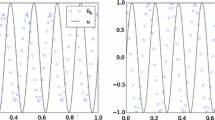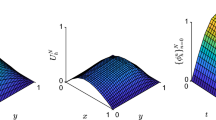Abstract
This paper deals with the coupling between one-dimensional heat and wave equations in unbounded subdomains, as a simplified prototype of fluid-structure interaction problems. First we apply appropriate artificial boundary conditions that yield an equivalent problem, but with bounded subdomains, and we carry out the stability analysis for this coupled problem in truncated domains. Then we devise an optimized Schwarz-in-time (or Schwarz Waveform Relaxation) method for the numerical solving of the coupled equations. Particular emphasis is made on the design of optimized transmission conditions. Notably, for this setting, the optimal transmission conditions can be expressed analytically in a very simple manner. This result is illustrated by some numerical experiments.











Similar content being viewed by others
References
Adams, R.A.: Sobolev Spaces. Pure and Applied Mathematics, vol. 65. Academic Press, New York-London (1975)
Arnold, A.: Numerically absorbing boundary conditions for quantum evolution equations. VLSI Des. 6(1-4), 313–319 (1998)
Astorino, M, Chouly, F., Fernández, M.A.: Robin based semi-implicit coupling in fluid-structure interaction: stability analysis and numerics. SIAM J. Sci. Comput. 31(6), 4041–4065 (2009/10)
Astorino, M., Chouly, F., Quarteroni. A: A time-parallel framework for coupling finite element and lattice Boltzmann methods. Appl. Math. Res. Express. AMRX (1), 24–67 (2016)
Badia, S., Nobile, F., Vergara, C.: Fluid-structure partitioned procedures based on Robin transmission conditions. J. Comput. Phys. 227(14), 7027–7051 (2008)
Badia, S., Nobile, F., Vergara, C.: Robin-Robin preconditioned Krylov methods for fluid-structure interaction problems. Comput. Methods Appl. Mech Eng. 198(33-36), 2768–2784 (2009)
Baskakov, V.A., Popov, A.V.: Implementation of transparent boundaries for numerical solution of the Schrödinger equation. Wave Motion 14(2), 123–128 (1991)
Abdallah, N.B., Méhats, F., Pinaud, O.: On an open transient Schrödinger-Poisson system. Math. Models Methods Appl. Sci. 15(5), 667–688 (2005)
Burman, E., Durst, R., Fernández, M.A., Guzmán, J.: Fully discrete loosely coupled Robin-Robin scheme for incompressible fluid-structure interaction:, stability and error analysis. arXiv:2007.03846 (2020)
Burman, E., Fernández, M.A.: Explicit strategies for incompressible fluid-structure interaction problems: Nitsche type mortaring versus Robin-Robin coupling. Int. J. Numer. Methods Eng. 97(10), 739–758 (2014)
Cao, S., Main, A., Wang, K.G.: Robin-Neumann transmission conditions for fluid-structure coupling: embedded boundary implementation and parameter analysis. Int. J. Numer. Methods Eng. 115(5), 578–603 (2018)
Causin, P., Gerbeau, J.-F., Nobile, F.: Added-mass effect in the design of partitioned algorithms for fluid-structure problems. Comput. Methods Appl. Mech. Eng. 194(42-44), 4506–4527 (2005)
Chouly, F., Fernández, M.A.: An enhanced parareal algorithm for partitioned parabolic-hyperbolic coupling. AIP Conf. Proc. 1168(1), 1517–1520 (2009)
Degroote, J.: On the similarity between Dirichlet-Neumann with interface artificial compressibility and Robin-Neumann schemes for the solution of fluid-structure interaction problems. J. Comput. Phys. 230(17), 6399–6403 (2011)
Discacciati, M., Gerardo-Giorda, L.: Optimized Schwarz methods for the Stokes-Darcy coupling. IMA J. Numer. Anal. 38(4), 1959–1983 (2018)
Doetsch, G.: Anleitung Zum Praktischen Gebrauch der Laplace-Transformation und der Z-Transformation, 4th edn. R Oldenbourg Verlag, Munich (1981)
Errera, M.-P., Duchaine, F.: Comparative study of coupling coefficients in Dirichlet-Robin procedure for fluid-structure aerothermal simulations. J. Comput. Phys. 312, 218–234 (2016)
Farhat, C., Cortial, J., Dastillung, C., Bavestrello, H.: Time-parallel implicit integrators for the near-real-time prediction of linear structural dynamic responses. Int. J. Numer. Methods Eng. 67(5), 697–724 (2006)
Fernández, M.A.: Coupling schemes for incompressible fluid-structure interaction: implicit, semi-implicit and explicit. SeMA J. (55), 59–108 (2011)
Fernández, M.A., Formaggia, L., Gerbeau, J.-F., Quarteroni, A.: The derivative of the equations for fluids and structure. In: Cardiovascular Mathematics, volume 1 of MS&A. Model. Simul. Appl., pp 77–121. Springer, Italia, Milan (2009)
Fernández, M.A., Gerbeau, J.F.: Algorithms for fluid-structure interaction problems. In: Cardiovascular Mathematics, volume 1 of MS&A. Model. Simul. Appl., pp 307–346. Springer, Italia, Milan (2009)
Fernández, M.A., Landajuela, M., Mullaert, J., Vidrascu, M.: Robin-Neumann schemes for incompressible fluid-structure interaction. In: Domain Decomposition Methods in Science and Engineering XXII, volume 104 of Lect. Notes Comput. Sci. Eng., pp 65–76. Springer, Cham (2016)
Fernández, M.A., Mullaert, J., Marina, V.: Explicit Robin-Neumann schemes for the coupling of incompressible fluids with thin-walled structures. Comput. Methods Appl. Mech. Eng. 267, 566–593 (2013)
Fernández, M.A., Mullaert, J., Vidrascu, M.: Generalized Robin-Neumann explicit coupling schemes for incompressible fluid-structure interaction: stability analysis and numerics. Int. J. Numer. Methods Eng. 101(3), 199–229 (2015)
Forti, D., Quarteroni, A., Simone, D.: A parallel algorithm for the solution of large-scale nonconforming fluid-structure interaction problems in hemodynamics. J. Comput. Math. 35(3), 363–380 (2017)
Gander, M.J.: Optimized Schwarz methods. SIAM J. Numer. Anal. 44(2), 699–731 (2006)
Gander, M.J.: On the influence of geometry on optimized Schwarz methods. SeMA J. (53), 71–78 (2011)
Gander, M.J., Halpern, L.: Méthodes de relaxation d’ondes (SWR) pour l’équation de la chaleur en dimension 1. C. R Math. Acad. Sci. Paris 336(6), 519–524 (2003)
Gander, M.J., Halpern, L., Nataf, F.: Optimal Schwarz waveform relaxation for the one dimensional wave equation. SIAM J. Numer Anal. 41(5), 1643–1681 (2003)
Gander, M.J., Jiang, Y.-L., Li, R.-J.: Parareal Schwarz waveform relaxation methods. In: Domain Decomposition Methods in Science and Engineering XX, vol. 91 of Lect. Notes Comput. Sci. Eng., pp 451–458. Springer, Heidelberg (2013)
Gander, M.J., Petcu, M.: Analysis of a Krylov subspace enhanced parareal algorithm for linear problems. In: Paris-Sud Working Group on Modelling and Scientific Computing 2007–2008, vol. 25 of ESAIM Proc. EDP Sci., Les Ulis, pp 114–129 (2008)
Gander, M.J., Vandewalle, S.G.: Analysis of the parareal time-parallel time-integration method. SIAM J. Sci. Comput. 29, 556–578 (2007)
Gander, M.J., Vanzan, T.: Heterogeneous optimized Schwarz methods for coupling Helmholtz and Laplace equations. In: Domain decomposition methods in science and engineering XXIV, vol. 125 of Lect. Notes Comput. Sci. Eng., pp 311–320. Springer, Cham (2018)
Gander, M.J., Vanzan, T.: Heterogeneous optimized Schwarz methods for second order elliptic PDEs. SIAM J. Sci Comput. 41(4), A2329–A2354 (2019)
Gerardo-Giorda, L., Nobile, F., Vergara, C.: Analysis and optimization of Robin-Robin partitioned procedures in fluid-structure interaction problems. SIAM J. Numer. Anal. 48(6), 2091–2116 (2010)
Gigante, G., Sambataro, G., Vergara, C.: Optimized Schwarz methods for spherical interfaces with application to fluid-structure interaction. SIAM J. Sci. Comput. 42(2), A751–A770 (2020)
Gigante, G., Vergara, C.: Optimized Schwarz method for the fluid-structure interaction with cylindrical interfaces. In: Domain decomposition methods in science and engineering XXII, vol. 104 of Lect. Notes Comput. Sci. Eng., pp 521–529. Springer, Cham (2016)
Gripenberg, G., Londen, S.-O., Staffans, O.J.: Volterra Integral and Functional Equations, vol. 34 of Encyclopedia of Mathematics and its Applications. Cambridge University Press, Cambridge (1990)
Halpern, L., Japhet, C., Szeftel, J.: Discontinuous Galerkin and nonconforming in time optimized Schwarz waveform relaxation. In: Domain Decomposition Methods in Science and Engineering XIX, vol. 78 of Lect. Notes Comput. Sci. Eng., pp 133–140. Springer, Heidelberg (2011)
Han, H., Huang, Z.: A class of artificial boundary conditions for heat equation in unbounded domains. Comput. Math Appl. 43(6-7), 889–900 (2002)
Lions, J.-L., Maday, Y., Turinici, G.: Résolution d’EDP par un schéma en temps “pararéel”. C. R. Acad. Sci. Paris Sér. I Math. 332(7), 661–668 (2001)
Lions, J.-L.: Problèmes aux Limites non homogènes applications. Vol. 1. Travaux et Recherches Mathématiques, vol. 17. Dunod, Paris (1968)
Lubich, C.: Discretized fractional calculus. SIAM J. Math. Anal. 17(3), 704–719 (1986)
Maday, Y.: Analysis of coupled models for fluid-structure interaction of internal flows. In: Cardiovascular Mathematics, vol. 1 of MS&A. Model. Simul. Appl., pp 279–306. Springer, Italia, Milan (2009)
Papadakis, J.S.: Impedance formulation of the bottom boundary condition for the parabolic equation model in underwater acoustics. NORDA Parabolic Equation Workshop, NORDA Tech. Note, 143, 01 (1982)
Podlubny, I.: Fractional Differential Equations, vol. 198 of Mathematics in Science and Engineering. Academic Press Inc., San Diego, CA (1999)
Richter, T., Wick, T.: On time discretizations of fluid-structure interactions. In: Multiple Shooting and Time Domain Decomposition Methods, vol. 9 of Contrib. Math. Comput. Sci., pp 377–400. Springer, Cham (2015)
Seboldt, A., Bukač, M.: A non-iterative domain decomposition method for the interaction between a fluid and a thick structure. arXiv:2007.00781 (2020)
Xu, Y.: The influence of domain truncation on the performance of optimized Schwarz methods. Electron. Trans. Numer. Anal. 49, 182–209 (2018)
Xu, Z., Zuazua, E.: Long-time behavior of a coupled heat-wave system arising in fluid-structure interaction. Arch. Ration. Mech. Anal. 184(1), 49–120 (2007)
Zheng, C.: Approximation, stability and fast evaluation of exact artificial boundary condition for the one-dimensional heat equation. J. Comput. Math. 25 (6), 730–745 (2007)
Acknowledgements
The two authors thank the two anonymous referees for their comments that allowed to improve the manuscript. They also thank Miguel A. Fernandez, Yvon Maday, Martin Gander, Véronique Martin, Christophe Besse and Xavier Antoine for stimulating discussions and helpful comments. This work was granted for access to the resources of the Mesocentre of Franche-Comté.
Funding
F.C. and P.K.’s work is partially supported by Université de Franche-Comté and Région Bourgogne Franche-Comté. F.C.’s work is partially supported by the I-Site BFC project NAANoD and the EIPHI Graduate School (contract ANR-17-EURE-0002).
Author information
Authors and Affiliations
Corresponding author
Additional information
Publisher’s note
Springer Nature remains neutral with regard to jurisdictional claims in published maps and institutional affiliations.
Rights and permissions
About this article
Cite this article
Chouly, F., Klein, P. Wave-heat coupling in one-dimensional unbounded domains: artificial boundary conditions and an optimized Schwarz method. Numer Algor 90, 631–668 (2022). https://doi.org/10.1007/s11075-021-01201-x
Received:
Accepted:
Published:
Issue Date:
DOI: https://doi.org/10.1007/s11075-021-01201-x




